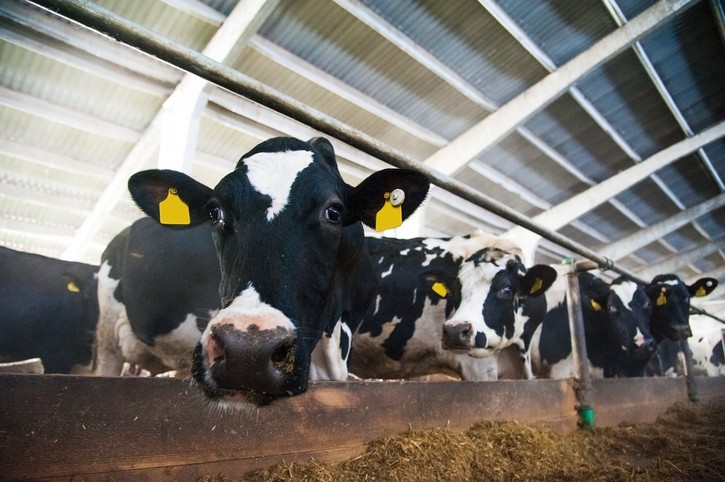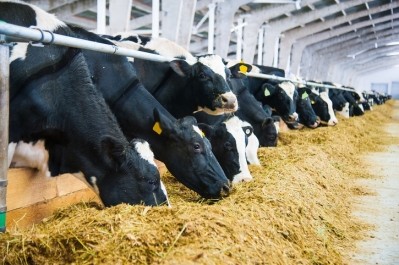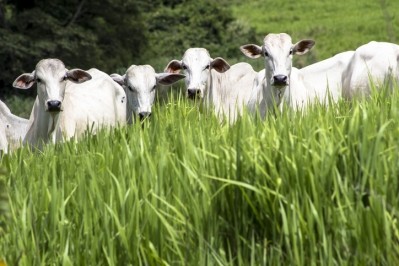Alternative antimicrobial chitosan may boost dairy cow feed efficiency

An international team of researchers from the US and Brazil explored dairy cow nutrient intake and digestibility along with ruminal fermentation, microbial protein synthesis, ruminal bacterial populations nitrogen (N) use and milk yield and composition when chitosan (CHI) and whole raw soybeans (WRS) were added the feeds.
The group published its work in the Journal of Dairy Science.
“The objective of this study was to evaluate the effects of CHI and WRS on nutrient intake and digestibility, ruminal fermentation and bacterial populations, microbial protein synthesis, N utilization, blood metabolites, and milk yield and composition of dairy cows,” the researchers said.
Overall, adding both the CHI and WRS reduced nutrient intake and digestibility for the cows, lowered milk yield and the production of solids, and reduced N intake and secretion in milk, the researchers said.
CHI boosted ruminal pH and reduced the acetate to propionate ratio, while WRS lowered the NH3-N concentration and the ruminal acetate to propionate level.
Both feed additives tended to alter the bacterial populations, but had no influence on ruminal fermentation or bacterial populations, they said. However, separately, both boosted milk yield efficiency for fat-corrected milk, energy-corrected milk and altered fatty acid concentrations.
“Evidence indicates that CHI provision in diets with no lipid supplementation improves feed efficiency of lactating cows, besides increasing the milk content of UFA [unsaturated fatty acids] and cis-9,trans-11 CLA [conjugated linoleic acid],” they said. “Feeding WRS instead of soybean oil as a fat source did not avoid the negative interaction effects with CHI on performance of cows and unchanged milk FA profile.”
Why chitosan and whole raw soybeans?
High-yielding dairy cows can see their milk production limited by their diet as they also have a high-energy need that can surpass their ability to take in nutrients, the researchers said. There also can be protein and energy inefficiencies that generate methane and excess ammonia N.
It is possible to modulate microbial fermentation to improve fermentation pathways and reduce such losses, either through changing cow diets or adding antimicrobials, they said.
“The use of ionophore antibiotics (e.g., monensin) in ruminant diets has shown to increase the rate of propionate production, decrease methane production, and reduce the ammonia accumulation in the rumen,” they added.
However, the use of ionophores in cow diets has had increasing global pushback stemming from questions of residue in animal products and the concerns regarding bacteria developing resistance to antibiotics, they said. Alternative antimicrobials for use in feed are increasingly of interest.
Chitosan is a biopolymer generated from chitin – a common polysaccharide and component in the exoskeleton of insects and crustaceans, they said. The biopolymer also has shown antimicrobial activity against multiple yeasts, fungi and bacteria.
“Chitosan interacts with the outer membrane proteins causing bacterial cell membrane disruption and cell death (Jeon et al., 2014). Although studies have evaluated CHI as an additive for silage preservation (Gandra et al., 2016a), or to prevent metritis (Daetz et al., 2016) and mastitis in dairy cattle (Lanctôt et al., 2017), few studies have evaluated the effects of CHI on ruminal fermentation in in vivo trials, especially with lactating cows,” the researchers said.
Previous research also demonstrated the ability of CHI to reduce the propionate to acetate ration in sheep, beef steers and lactating cows, they added.
Chitosan also has been linked to a ruminal reduction in biohydrogenation and improved feed efficiency and higher milk UFA levels for when cows had a soybean-oil-free diet, they said. However, when CHI and soybean oil were both added to cow diets a negative effect on cow performance was noted.
“The reasons for the latter associative effect are not clear because no differences in nutrient intake and digestibility, and ruminal VFA [volatile fatty acid] concentration were detected between cows fed the diet with soybean oil and the diet with soybean oil along with CHI,” they added.
Lipid supplements can be used to boost the energy density of diets for high-yield dairy cows, they said. However, the type of supplementation – rumen-protected or unprotected – can lower select bacteria populations.
Using whole oilseeds to provide dietary fatty acid supplementation has demonstrated slight negative effects on ruminal fermentation, the researchers said. Whole raw soybeans (WRS) can provide a rumen-protected fat source that also increases the flow of UFA, and are cheaper than other protected fat sources.
“We hypothesized that the negative interaction between CHI and UFA (soybean oil) supplementation on performance observed by Del Valle et al. (2017) would be eliminated by feeding CHI and WRS,” they said. “We expected that CHI and WRS combination would improve ruminal fermentation, alter ruminal bacterial populations, and increase UFA concentration in milk of cows.”
Feeding trial details
In the feeding trial, 24 cows were given one of four diets for a 23-day period before being rotated to another trial diet, the researchers said.
The corn silage, corn and soybean meal-based diets included varying levels of WRS at 0 or 14% diet dry matter (DM) and differing amounts of CHI at 0 or 4g/kg DM.
Feed ingredients were checked for DM, ether extract, acid detergent fiber (ADF), lignin, ash, neutral detergent fiber (NDF), organic matter and fatty acid profile, they said. Daily feed intake was calculated, total-tract apparent digestibility of nutrients was established, fecal samples were taken on days 21-23 of each diet rotation for analysis and ruminal digesta samples were collected every two hours through 12 hours post feeding on day 19 of each period.
Ruminal samples were checked for pH levels, VFA, NH3-N and bacterial levels, said the researchers. Milk yield was recorded and milk samples were taken on days 16-19 to check for fat, protein, lactose, fatty acid profile and urea concentration and energy-corrected milk was calculated.
Milk and urine samples also were analyzed to establish microbial N synthesis (micN), they said. Blood samples were collected on day 18 of each feeding period to check for serum glucose and total cholesterol.
Results
Overall the hypothesis was not proved, said the researchers.
“To the best of our knowledge, no data are available regarding the effects of CHI and WRS on nutrient digestibility, metabolic profile, and performance of lactating dairy cows,” they said. “Our research group evaluated CHI provision to cows fed a diet with soybean oil and we found similar interaction effects observed in the current study, including decreased DMI and milk yield (Del Valle et al., 2017). Thus, the hypothesis that supplementing WRS instead of soybean oil could eliminate the negative effects of CHI and UFA supplementation on performance was not accepted.”
A negative interaction was found between CHI and WRS in the diets and was noted for intake of DM, organic matter, crude protein, NDF and non-fiber carbohydrates and on the digestibility of DM, organic matter, NDF and EE, they said.
However, cows receiving CHI in their feed saw similar nutrient intake and digestibility to those on the control, they said. Diets with WRS boosted EE intake but lowered total-tract digestibility in cows,
“Provision of CHI to dairy cows fed a diet supplemented with WRS alters the ruminal fermentation and bacterial population, increasing the milk content of UFA, but decreases nutrient intake and digestibility, microbial protein synthesis, and milk yield,” the researchers said.
Rumen fermentation and ruminal bacterial populations were not altered when both feed additives were present, they said. However, there was a negative interaction on micN and on the yields of lactose, protein, milk, fat-corrected milk and energy-corrected milk.
Cows with CHI-supplemented diets had higher ruminal pH and a larger propionate molar proportion than those without the additive, they said. CHI diets also lowered the concentrations of acetate and valerate, acetate to propionate ratio and the acetate molar proportion, along with decreasing levels of some bacteria populations.
Adding CHI to the diets did not alter N use by the cows, they said. However, it did lower the concentration of total saturated fatty acids and the SFA to UFA ratio, while increasing the levels of total monounsaturated fatty acids (MUFA) and polyunsaturated fatty acids (PUFA) and several individual fatty acids.
“In terms of milk synthesis efficiency, cows fed diets with CHI and without WRS had the highest values of feed efficiency, whereas cows fed diets with WRS had intermediate values, and CON exhibited the lowest values of feed efficiency,” the researchers said. “The CHI had no effect on blood metabolites, but WRS decreased blood concentrations of glucose and increased blood concentration of total cholesterol.”
Diets with additive WRS lowered ruminal NH3-N, butyrate concentration, the molar proportion of acetate and butyrate and some ruminal bacteria populations while boosting others, they said. It increased the molar proportion of propionate.
When WRS were added to the diet, urinary N excretion lowered and fecal N output increased, they said. However, it increased milk fat concentration and lowered urea concentration in milk along with the efficiency of milk N production.
“WRS increased long-chain FA, total MUFA, PUFA, and 18:0 to UFA ratio in milk of cows,” they said. “The WRS decreased total SFA, FA with odd carbon chain, and total SFA to UFA ratio in [the] milk of cows.”
Source: Journal of Dairy Science
Title: Effects of chitosan and whole raw soybeans on ruminal fermentation and bacterial populations, and milk fatty acid profile in dairy cows
Authors: F. Zanferari, T. Vendramini, M. Rentas, R. Gardinal, G. Calomeni, L. Mesquita, C. Takiya, F. Rennó
DOI: doi.org/10.3168/jds.2018-14675
















